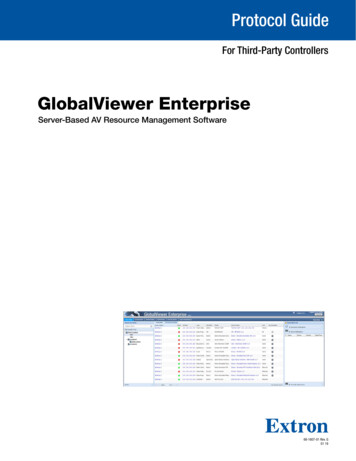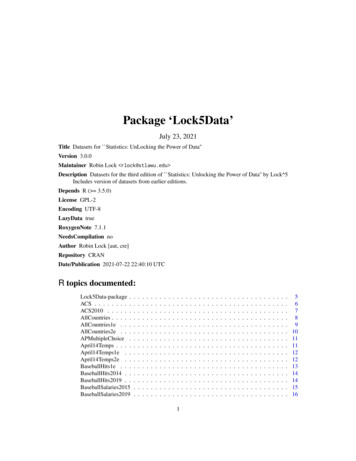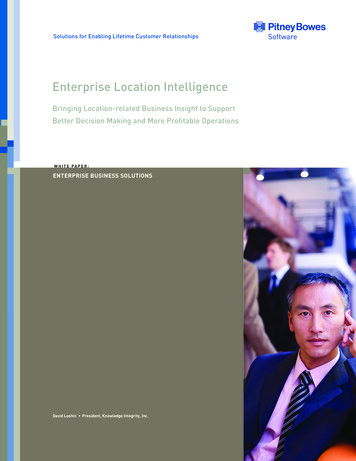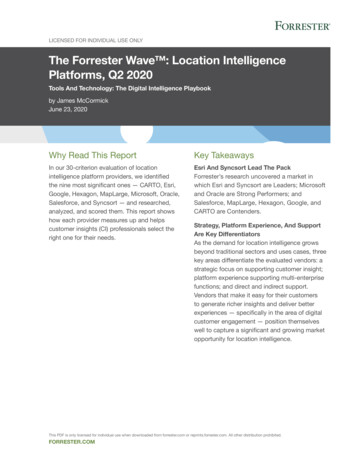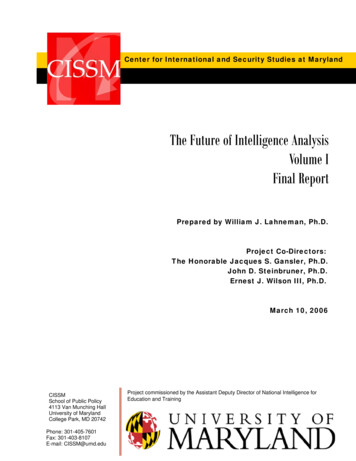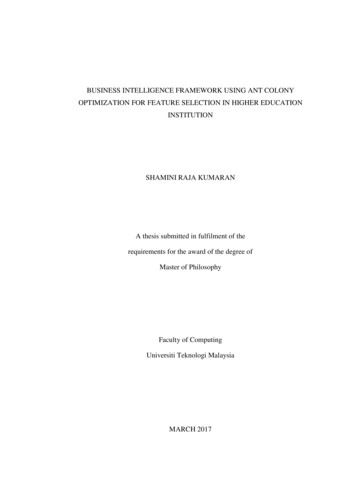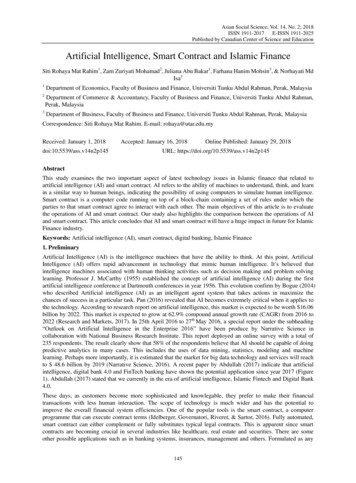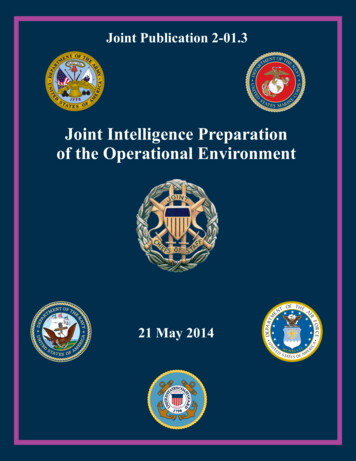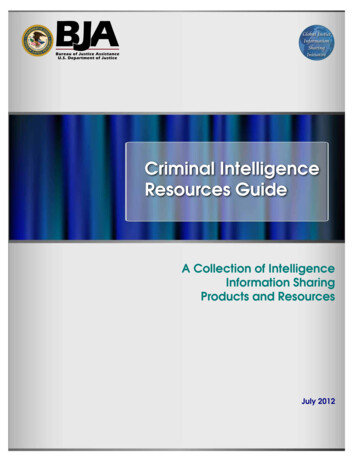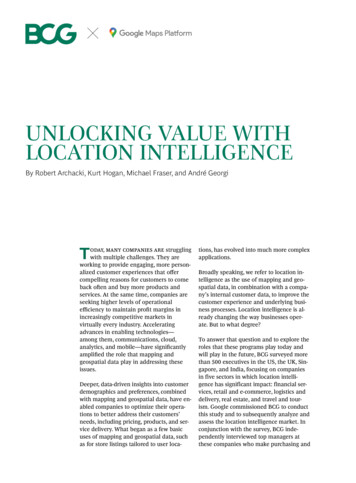
Transcription
UNLOCKING VALUE WITHLOCATION INTELLIGENCEBy Robert Archacki, Kurt Hogan, Michael Fraser, and André GeorgiToday, many companies are strugglingwith multiple challenges. They areworking to provide engaging, more personalized customer experiences that offercompelling reasons for customers to comeback often and buy more products andservices. At the same time, companies areseeking higher levels of operationalefficiency to maintain profit margins inincreasingly competitive markets invirtually every industry. Acceleratingadvances in enabling technologies—among them, communications, cloud,analytics, and mobile—have significantlyamplified the role that mapping andgeospatial data play in addressing theseissues.Deeper, data-driven insights into customerdemographics and preferences, combinedwith mapping and geospatial data, have enabled companies to optimize their operations to better address their customers’needs, including pricing, products, and service delivery. What began as a few basicuses of mapping and geospatial data, suchas for store listings tailored to user loca-tions, has evolved into much more complexapplications.Broadly speaking, we refer to location intelligence as the use of mapping and geospatial data, in combination with a company’s internal customer data, to improve thecustomer experience and underlying business processes. Location intelligence is already changing the way businesses operate. But to what degree?To answer that question and to explore theroles that these programs play today andwill play in the future, BCG surveyed morethan 500 executives in the US, the UK, Singapore, and India, focusing on companiesin five sectors in which location intelligence has significant impact: financial services, retail and e-commerce, logistics anddelivery, real estate, and travel and tourism. Google commissioned BCG to conductthis study and to subsequently analyze andassess the location intelligence market. Inconjunction with the survey, BCG independently interviewed top managers atthese companies who make purchasing and
collaboration decisions about geospatialdata and about mapping platform programs and providers.geospatial data is nice to have, but now it’sa must-have for a company like ours togrow revenues and ensure personalizedcustomer experiences.”The first thing that stands out in our research is the extent to which these sectorsalready depend on mapping and geospatialdata to enhance business processes. (SeeExhibit 1.) Of the executives surveyed, 95%said that mapping and geospatial data areimportant in achieving desired business results today, and 91% said that it will beeven more essential in three to five years.As further evidence that location intelligence is very important in many businesses, more than 50% of respondents said thattheir C-level executives participated in thedecision-making process pertaining to using mapping service providers. Often, thisrequired cross-functional participation—including IT/digital, strategy, operations,finance, and marketing—emphasizing theinterdisciplinary nature of the opportunity.In describing the impact of location intelligence programs, the director of digitalproduct management at a global financialservices company said, “If you had askedsix to seven years ago, I would have saidWhat Drives Success?Not every company can claim high levelsof returns from its location intelligence program. In our study, we found that certainattributes of location intelligence programsare more closely correlated with successthan others. The factors with the highestcorrelation to performance included thedegree of alignment between mapping andgeospatial data and a company’s core business strategy, the extent to which the company employs location intelligence acrossits business, the maturity of the company’sunderlying location intelligence capabilities, and the effectiveness of its efforts tomeasure value from location intelligenceinitiatives.Using the respondents’ self-reported maturity on these factors, we categorized theminto three location intelligence archetypes—followers, challengers, and leaders—defined as follows:Exhibit 1 Already Valuable Today, Location Data Will Drive Even Better Business Results overthe Next Three to Five YearsImportance of location data to businessperformance today, by sectorChange in importance of location data tobusiness performance in 3 to 5 years, by sectorRespondents who answered “somewhat important”or “very important” (%)Respondents who answered “somewhat more important”or “substantially more important” istics andanddeliverye-commerceVery important9475702524RealestateSomewhat importantAverage95%Travel 147Average91%5926RetailLogistics andanddeliverye-commerceSubstantiallymore importantRealestateTravel andtourismSomewhatmore importantSources: Global BCG Survey on Location Intelligence for Enterprises (n 520), October 2020; BCG analysis.Boston Consulting GroupXGoogle 2
Location Intelligence Followers—companies that are in the early stagesof using location intelligence, withlimited implementation of mostly basicuse cases, typically lagging behindpeers Location Intelligence Challengers—companies that are seeing early benefitsfrom implementing location intelligencebut can further expand the number andsophistication of use cases across theirorganizations and build strongerlocation intelligence capabilities Location Intelligence Leaders—companies that have defined a holisticlocation intelligence data strategy, builtstrong in-house location-based capabilities, and incorporated more advancedlocation-based use cases across multiplebusiness areas and customer journeysOnly about 15% of the companies we surveyed qualified as location intelligenceleaders, while the lion’s share (45%) consisted of location intelligence challengers.Examining these categories by sector, wefound that financial services had the highest percentage of leaders (21%), with retailand e-commerce (18%) close behind.Although all types of companies enjoysome gains from location intelligence applications, leaders far outshine the others.Leaders reported improvements that were1.3 to 2.0 times as great as those achievedby followers in three key metric categories:customer experience, sales performance,and operational efficiency. (See Exhibit 2.)These higher returns did not vary significantly by industry, company size, or digitaladoption relative to peers.A Broad Spectrum of LocationIntelligence UsesSurvey respondents reported that they usemapping and geospatial data across eightcategories and more than 100 specific applications. (See Exhibit 3 and the Appendix.) Customer-facing categories includegeomarketing, digital customer experienceenhancement, on-premises customer experience enhancement, and zone-based pricing. Operations-oriented categories includeroute planning and optimization, networkand supply chain optimization, workforcecoverage optimization, and support function optimization.On average, the most active companiesleverage geospatial data to implement ap-Exhibit 2 Location Intelligence Leaders Drive Approximately 1.3 to 2.0 Times as Much Impacton Key Metrics as FollowersImpact on select metrics related tocustomer experience (%)Impact on select metrics related tosales funnel (%)Impact on select metrics related tooperational efficiency (%) 2.0x 1.4x16.17.78.516.413.88.37.8Followers14.6Leaders ers11.110.78.2Customer retentionRevenue growthNumber of support callsCustomer satisfactionOnline to offline conversionAverage time to fulfill serviceNet promoter scoreTime spent on websiteError rate for address entryLeadersSources: Global BCG Survey on Location Intelligence for Enterprises (n 520), October 2020; BCG analysis.Note: The impacts shown in the bar charts are average percentage gains in select metrics for customer experience, sales, and operations.Boston Consulting GroupXGoogle 3
Exhibit 3 Executives in Multiple Industries Use Location Intelligence in a Wide Array of Use CasesRespondents employing use cases, by sector dlogisticsRealestateTravel andtourism6378536869Digital customer experience enhancement (e.g.,location to optimize the online customer experience,such as store location or address auto-completion)6965435973On-premises customer experienceenhancement (e.g., location-based information to363804860Zone-based pricing (e.g., pricing adjustments e case categoriesGeomarketing and targeted communicationsCustomer-facing(e.g., geospatially based promotions forproducts/services)improve the in-store customer experience)products, assets, and services based on location)Route planning and optimization (e.g., use ofOperationalmaps and geospatial data to optimize fleet’s driving,delivery, and pickup routes)Network and supply chain optimization (e.g.,use of maps and geospatial data to optimize store,branch, office, and warehouse placement)Workforce coverage optimization (e.g., use ofmaps and geospatial data to allocate staff andsalesforce to maximize coverage and efficiency)Support function optimization (e.g., use of mapsand geospatial data to authenticate users and to detectand prevent fraud)Level of useNo useLowMediumHighSources: Global BCG Survey on Location Intelligence for Enterprises (n 520), October 2020; BCG analysis.plications across five to seven categories.(See the sidebar “How Companies Evolvefrom Basic to Advanced Location Intelligence Applications.”)Geomarketing, which consists chiefly oflocation-based promotions and advertisingfor products and services, is widely usedacross all five industry sectors for customers who have opted in. At least half and upto 78% of respondents say that they haveimplemented these programs. Retail ande-commerce outfits deploy geomarketing tothe greatest extent, while logistics and delivery firms are less likely to adopt thistechnique. Geomarketing programs typically include customized marketing messagesbased on a customer’s location; maps to lo-cate nearby stores highlighting discountsand deals; personalized messaging and offers linked to where customers shop andwhat brands they prefer, if they opted in;and measurement of the incremental impact of these offers and promotions on customer spending.Companies use geospatial data to enhancethe digital customer experience across industry sectors, but especially in travel andtourism, retail and e-commerce, and financial services. (See the sidebar “An OnlineBank Uses Geospatial Data to Address anUnderserved Market.”) Such applicationsinclude autocompletion of address information for online checkout and search; virtual tours of sites and locations; map-basedBoston Consulting GroupXGoogle 4
HOW COMPANIES EVOLVE FROM BASIC TO ADVANCEDLOCATION INTELLIGENCE APPLICATIONSMapping and geospatial data programsare progressing at a rapid pace, enablingcompanies that adopt these applicationsto move quickly from simple offerings tomore complex uses. We looked closely attwo industries in which location intelligence is increasingly essential, to seehow companies continually enhance thescope and impact of their location intelligence activities.Retail and E-CommerceRetailers typically begin using locationintelligence to support fairly basiccustomer-facing activities, such ashelping them find store locations or usean autocomplete utility to simplifyonline search or address entry. Today,these are table stakes applications.As retailers’ location intelligencecapabilities have advanced, moresophisticated uses involving optimizingthe end-to-end customer experiencehave emerged, including the following: Making store-level inventory datavisible to customers to confirm that aproduct is available before they cometo a store to buy it Scheduling store-specific appointments and consultations Developing optimized shopping listsand store-level shopping guidance tolocate products efficiently Making in-store recommendationsbased on a customer’s past purchases, known preferences, and locationwithin the store Optimizing the store experience byusing location intelligence to predictqueuing Using geomarketing to communicatewith customers who are near storesand who have opted in, enticing themto shop by presenting them withrelevant offersA growing number of retailers also uselocation intelligence when planning storelocations, taking into account directattributes of the particular location (suchas urban versus suburban and level ofexpected foot traffic), but also understanding the surrounding environs at agranular level to support better planningdecisions. This includes leveraginggeospatial data on available transportation modes, parking facilities, competitors’ store locations and plans, andnearby retailers and points of interestthat may have complementary trafficpatterns.As retailers develop their e-commercebusinesses, some have used locationintelligence to improve their management and tracking of in-store pickup andhome delivery of products. Theseprograms aim to ensure that items areavailable when promised at retail outletsor, if shipped, are picked up by drivers onroutes and schedules that are dynamically optimized for maximum efficiencyand timely delivery, cutting costs andkeeping customers satisfied. One formerhead of online and digital operations ata chain retailer told us that the company“found a 3% to 4% reduction in deliverycosts for online orders by better optimizing the fleet.”Logistics and DeliveryInitially, logistics companies tend tofocus on fleet optimization and enhanced package delivery tracking astheir core location intelligence applications. Over time, though, some logisticscompanies expand their use of locationintelligence to include helping theirlargest customers plan their shippinglocations for maximum efficiency. Forinstance, helping shippers locate theirBoston Consulting GroupXGoogle 5
HOW COMPANIES EVOLVE FROM BASIC TO ADVANCEDLOCATION INTELLIGENCE APPLICATIONS(continued)facilities for maximum coordination withthe logistics vendor’s pickup routes andschedules can improve the timeliness ofpackage pickup, save delivery time, andreduce shipping costs.Some logistics companies have alsoleveraged location intelligence toenhance the end customer’s packagedelivery experience—for example, byoffering target time windows for delivery,enabling real-time rescheduling ofpackage delivery if no one will be athome to receive it, and using locationintelligence to select the retail store orsearch for products and services; and listings of inventory, services, hours, and directions for nearby facilities and outlets.For example, in the real estate sector, companies often connect the map interface directly to location-based property data togive prospective home buyers a multidimensional picture of the neighborhoods,property attributes, commute times, nearbyschools, and valuations in the areas theyare considering. According to a projectmanager at one online real estate firm,map-based search has become so critical tocustomers that the speed at which the maploads “has a large impact on conversion—adelay of one to two seconds can drive a decline in search-to-listing conversion of 10%to 15%.”Besides being critical for purely online experiences, location intelligence is increasingly involved in efforts to enhance in-storeshopping by integrating mobile devices andlocation data. For instance, grocers may display a smartphone map that shows shoppers where to find each item included on ashopping list that they create online beforevisiting the store. More advanced retail applications might make product suggestionsand point out store locations on the basisof past purchasing behavior.distribution center to hold the productfor pickup.Logistics company executives whoresponded to our survey indicated thatby using dynamic route planning andoptimization they were able to increasethe number of deliveries per driver by4% to 7%. In addition, using locationintelligence to provide real-time trackingof vehicles and cargo enabled them toimprove their customer satisfactionscores by 6% to 11%.To improve operations efficiency and reduce costs, companies use location intelligence for network and supply chain optimization. This is particularly prevalent inretail and e-commerce (60%), logistics anddelivery (56%), and financial services (49%).Typically, these businesses use mappingand geospatial data to determine the mostpromising sites for stores, branches, offices,or warehouses, depending on the locationsof customers and suppliers and on location-based cost considerations. For instance, retailers might combine demographic data, proxies for local demand(such as nearby ATMs, gas stations, andshopping malls), the availability of publictransportation, and the condition of nearbyroad networks to assess the best markets toenter and the most promising locationswithin each potential market.Another relatively mature operationsoriented option is route planning andoptimization—which, not surprisingly,about three-quarters of all logistics and delivery companies employ. (See the sidebar“Beverage Company Uses Location Intelligence to Fill Drink Orders in Hours.”) Thesecompanies use location intelligence to determine the most efficient way to routepackages and deploy vehicles from pickupBoston Consulting GroupXGoogle 6
AN ONLINE BANK USES GEOSPATIAL DATA TOADDRESS AN UNDERSERVED MARKETCurrent, based in the US, is a mobilebank that targets customers who livepaycheck-to-paycheck—people whomtraditional banks tend to avoid becausethey cannot serve them profitably.Current innovatively leverages locationdata primarily to provide real-time pointsand cash back to cash-sensitive customers. The company’s location intelligenceapplications include the use of geospatial search to connect location toin-person purchases; geofencing-basedtargeted marketing to make relevantlocation-based offer recommendations;standardized payment receipts with storebrand images and location to minimizecalls to validate charges; locationmonitoring to reduce fraud related tocredit and debit card use; and parentalcontrols on teen banking accounts toblock spending at certain vendors on thebasis of location or a maximum spending limit.Current’s most powerful locationintelligence application, however, is apoint-based rewards platform forcustomers who use their debit cards atnearby retail sites. By increasing pointsfor targeted retailers during promotionalperiods, Current has seen an uptick inspending of as much as five timeslocation to destination. “Optimizing fleetdelivery routes through real-time guidanceresulted in saving about 30 minutes pereight-hour shift, which is about 6% in delivery time and cost,” said the principal for robotics and operations for a large globalshipper.Use of Location Intelligence bySector Differs but Benefits AreSimilarAlthough priority uses for location intelligence vary by industry among the sectorswe assessed, location intelligence generallyhad a significant reported impact on keyweek-over-week at one fast-food chain, aswell as an 8% lift in basket size and a10% increase in shopping frequency aspart of a multiple-month campaign withanother national restaurant chain. Asimilar campaign with a leading pharmacy chain delivered a 6% gain in averagebasket size and a 3% increase in frequency.“Location-based transaction attributionis central to our rewards platformbusiness model,” Current’s chieftechnology officer Trevor Marshall said.“We are able to circumvent traditionalcostly attribution models and providemore granular targeting to our merchantpartners. By proving the lift of campaignswith high precision, we are able to garnermuch higher reward amounts for ourusers. Location-based attribution enablesus to provide real-time rewards forcash-sensitive customers, which they canuse immediately. Not only are weproviding many customers with their firstcard-based rewards program, we’re ableto offer best-in-class reward amountsand a superior user experience, allowingthem to leapfrog existing options thathave not been properly serving them.”metrics across a similar range—a highsingle-digit to low double-digit percentageimpact. Here are some examples.On average, logistics and delivery companies reported a 5% to 11% reduction in delivery costs and a 6% to 11% increase incustomer satisfaction. This sector primarilyuses location intelligence for dynamicroute planning and real-time vehicle andcargo tracking.Financial services companies included inour survey reported 8% to 17% more usertime spent in apps that offered locationbased, tailored experiences. In addition,Boston Consulting GroupXGoogle 7
BEVERAGE COMPANY USES LOCATION INTELLIGENCETO FILL ORDERS IN HOURSFlaschenpost, a German online drinksdelivery company, is a relatively youngstartup with an ambitious goal: to deliverdrinks to households and offices withintwo hours of the order, eliminating theneed for customers to carry heavybottles and wait in long lines for bottlereturns. To do this, Flaschenpost relieson in-house operational capabilities andlocation intelligence to manage routingoptimization for drivers. This includesconfirming customer locations andproviding drivers with turn-by-turnnavigation that takes into account roadconditions and other location-basedfactors. By automating driver decisionmaking, the company reduces drivingtime and errors and meets time-baseddelivery goals.such companies have reduced fraudulenttransactions and account applications byup to 30% by using geospatial data to verifycustomers’ addresses and flag possible dishonest activity.Retail and e-commerce companies saidthat they increased their average onlinecart size by 11% to 15% by using locationintelligence to provide more personalizedand timely promotions. They also reducedaverage delivery costs by 3% to 4% whengeospatial data supported last-mile logistics programs.In certain sectors, location intelligence isenabling companies to develop disruptivebusiness models. For example, a Europeanonline challenger bank outpaced brick-andmortar competitors by using address validation to stem fraud in the application process, primarily by screening for peoplesetting up multiple accounts in remote locations. With this security in place, thebank could offer customers instant accounts and such additional location-basedfeatures as logging credit transactions onthe basis of merchant location to makeidentification easier.Flaschenpost’s location intelligenceprogram has improved customer satisfaction and increased the likelihood thatcustomers will order again. It also hasenlarged the average number of dailydeliveries that each driver can complete,thereby reducing delivery costs. “Everyminute is crucial for us in terms offinancial sustainability and customerexperience,” said Aron Spohr, Flaschenpost’s chief technology officer. “Evensmall improvements in location dataaccuracy can have significant impacts. Byusing better location data we were ableto improve estimated delivery time by 2minutes, which in turn saved our 1,400drivers 30 minutes per driver per day.”A company in the takeout food deliverysector is disrupting traditional businessmethods by innovatively using location intelligence programs to facilitate customerordering and to efficiently identify androute drivers. Customers who use this company’s app can track delivery progress inreal time. The manager of marketplacegrowth for this company estimates that“adding maps into the customer experiencefor pickup orders improves the conversionrate by about 2 percentage points.” Thecompany has also used geospatial data tooptimize pricing in response to differencesin local pricing elasticity. That programalone is worth “up to 25% of EBITDA,” according to the manager.Some map-enhanced use cases in varioussectors have already been around for several years and have become table stakes asthe feature no longer serves as a differentiating element of the experience, but ratherhas become a core customer expectation.For instance, financial services activitiessuch as profiling and segmenting customers and providing directions to branchesand ATMs are now table stakes. And intravel and tourism, maps showing possibleBoston Consulting GroupXGoogle 8
itinerary and lodging locations are a requirement. Still, it is essential for companies to execute these mature uses well. Asthe head of data and customer analytics ata major travel site put it, “As our industrybecomes much more competitive and theuse of maps is now standard practice, wehave focused more on doing the fundamentals exceedingly well—for example,keeping the map up-to-date and leading onconsistency and quality of data.”ing location intelligence and using it acrossan organization. Most survey respondentsreported relying on a wide range of metrics to track the success of their locationintelligence programs. (See Exhibit 4.) Thenumber of metrics employed across allcompanies ranged from 6 for on-premisescustomer experience enhancement to 26for network and supply chain optimization. On average, individual companies reported using 5 to 11 key metrics to monitor the success of their location programsfor each use case category.Whether it disrupts or serves as tablestakes, location intelligence is an importantcapability across industries. Consequently,companies must use mapping and geospatial data to continuously innovate and tosupport more routine uses that remain critical to optimal execution.Whichever metrics a company decides touse, leaders typically employ four fundamental measurement capabilities to evaluate the performance of their location intelligence programs.First, they model the return on the initialinvestment in developing location intelligence capabilities. This step is important injustifying the decision to implement amapping and geospatial data platform.More advanced companies also measurethe program’s actual ROI over time as theydeploy the capability, make subsequent investments, and realize benefits.Measurement—A Key toUnlocking ValueA company’s ability to measure value fromlocation intelligence programs correlatespositively with realizing greater value fromlocation intelligence. This finding indicatesthat developing a nuanced understandingof value is important to successfully adopt-Exhibit 4 Various Metrics Are Employed Across Use Case CategoriesOperational use casesCustomer-facing use casesUse ns insurvey)GeomarketingDigital perienceenhancementZone-basedpricingRoute planningand optimizationNetwork/supplychain optimizationWorkforcecoverageoptimizationSupport functionoptimizationRevenue growthTime spent in appAverage deliverytime per orderNet promoterscoreCustomersatisfaction scoreCustomersupport callsTime spent onwebsiteAverage keystrokesto completeaddressRevenue growthAddress entry errorrateCustomerretention rateApp bounce rateCustomersatisfaction scoreCustomersatisfaction scoreNet promoterscoreError rate foraddress entryApp bounce rateCustomerretention rateCustomersatisfaction scoreWebsite bouncerateCustomerretention rateRevenue growthGross profitmarginFraud incidentsTotal numberof metricsemployedacross allrespondents172161723262111Averagenumber ofmetrics usedby respondent1011589757Strategic/financial metricsTactical metricsSources: Global BCG Survey on Location Data for Enterprises (n 520), October 2020; BCG analysis.Boston Consulting GroupXGoogle 9
Second, leaders conduct A/B testing. An essential technique for isolating the incremental impact on business results of incorporating mapping and geospatial data inuse cases, A/B testing involves, among other things, showing different customer segments variants of a customer experiencethat uses location intelligence and gaugingwhich variant most effectively drives customer engagement and revenue gains.More advanced companies continuouslyconduct A/B testing at scale.Third, they more effectively use customerresearch, such as surveys and focus groups,to identify critical pain points and assesshow to apply location intelligence to mitigate them. Armed with these insights, companies can track the impact of their effortsthrough focused measurements.Fourth, advanced companies use multitouch attribution models to tie revenue tolocation intelligence programs and tactics.These models help analysts assess the relative contribution and ROI of various customer interactions by attributing credit fora sale to specific customer engagements.Seven Lessons from LocationIntelligence LeadersOur numerous eye-opening conversationswith location intelligence leaders yieldedprofiles of companies at the forefront of using new types and sources of geospatialdata and intelligence to enhance their businesses and improve their revenues, profitstreams, and customer relationships. (Seethe sidebar “Tales from Location Intelligence Leaders.”) Here are the most important lessons we gleaned from our discussions with location intelligence leaders.Think broadly and strategically about howto leverage location intelligence to enhance customer experience and improveoperational efficiencies. Look for ways touse mapping and geospatial data holistically and innovatively, moving beyond a focuson individual uses to optimize companywide synergies across applications—forinstance, by using geomarketing or customer experience personalization, on the onehand, while increasing supply chainefficiencies, on the other.Anticipate new digital business modelsand shifting customer expectations inwhich mapping and geospatial data play acentral role in enabling new value propositions. The COVID-19 pandemic has accelerated digitization and the opportunity fortechnology to play a larger role as aninterface with customers in all settings. Inthis environment, companies shouldexplore innovative uses of location intelligence that leverage
strong in-house location-based capabili-ties, and incorporated more advanced location-based use cases across multiple business areas and customer journeys Only about 15% of the companies we sur-veyed qualified as location intelligence leaders, while the lion's share (45%) con-sisted of location intelligence challengers.
